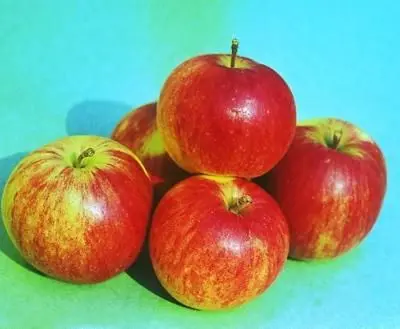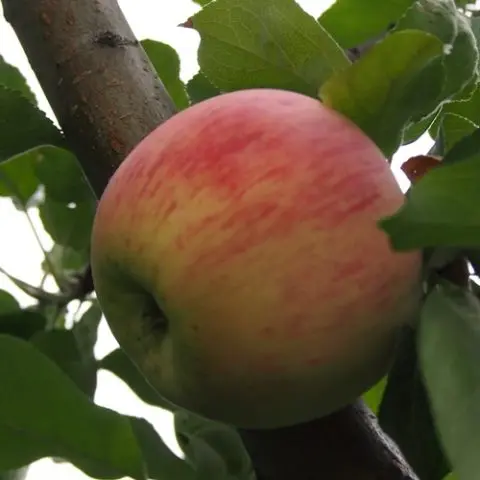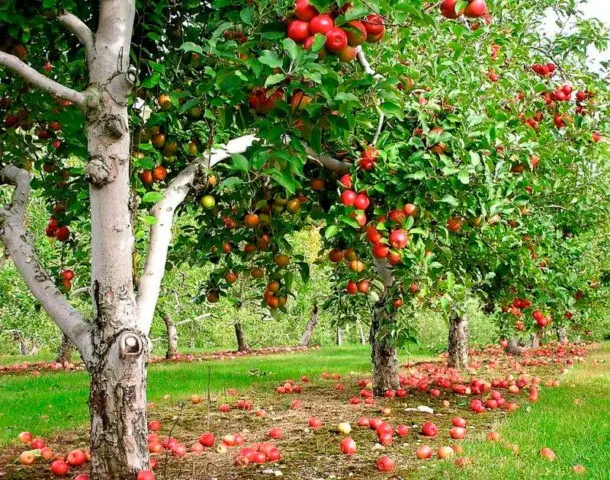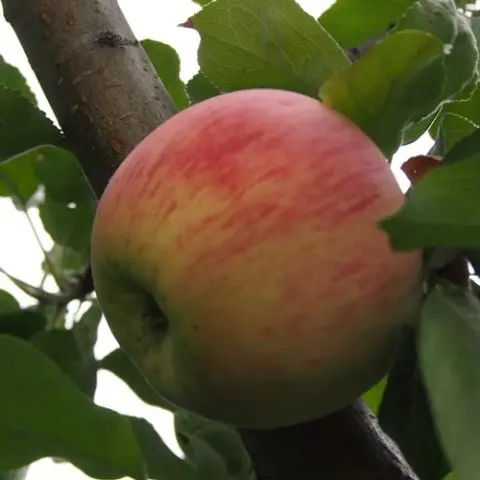Contents
Apple tree Bessemyanka Michurinskaya is one of the unpretentious autumn varieties that give good yields. The fruits of this tree tolerate transportation and wintering well, are suitable for eating raw, as well as for subsequent processing.
History of breeding
The apple tree variety Bessemyanka Michurinskaya was bred by the biologist-breeder Ivan Vladimirovich Michurin in 1913 as a result of crossing Bessemyanka Komsinskaya and Skryzhapelya varieties. The scientist set himself the goal of obtaining a variety that is resistant to growing in regions with a cold climate, in conditions of frequent snowstorms and winds. 8 years after receiving the seedling, it was possible to grow the first fragrant fruits with delicious sweet and sour pulp.

Apple tree Bessemyanka Michurinskaya is an environmentally sustainable and high-yielding variety
Description of the apple variety Bessemyanka Michurinskaya with a photo
The apple-tree variety Bessemyanka Michurinskaya quickly became widespread. The plant is suitable for growing in small private plots, as well as in production plantations.
Appearance of fruit and tree
An adult fruit-bearing tree is medium or above average in height, distinguished by powerful few branches. The crown of young trees is oval, becoming broad and rounded over time.
Description of the Bessemyanka Michurinskaya apple tree:
- branches are thick, not long, without pubescence;
- bark color – light brown;
- leaves are slightly wrinkled, with an edge turned up, dark emerald color;
- stalks are thick and round.
Medium-sized fruits (weighing up to 160 g), roundish, slightly flattened in the center. The peel is green-yellow, with red stripes, covered with a waxy coating.
From the side where the apples are intensely lit by the sun, bright red spots can often be seen. The seed nest of the fruit is bulb-shaped, the chambers are closed, with 1-2 seeds, or no seeds at all.
Life time
Planted on a hill in a suitable climatic zone, the Bessemyanka Michurinskaya apple tree can live for more than 75 years. The main condition for the longevity of a fruit tree is proper timely care:
- feeding with fertilizers;
- pruning;
- watering;
- loosening of the soil;
- weed removal.
Taste
The pulp of the ripe fruits of the Bessemyanka Michurinskaya apple tree has a creamy hue, the taste is sweet with sourness. Apples are very juicy, fragrant, rich in vitamin C (20-21 mg per 100 g of pulp). The total amount of sugars in ripe fruits is about 11%, acids – 0,7%.

The fruits of Bessemyanka Michurinskaya are green-yellow, with crimson spots on one side, flowing into stripes on the other
Growing regions
Bessemyanka Michurinskaya is mainly grown in the Central and North-Western regions of Our Country, as well as in the East of Siberia. The tree is not afraid of winds, storms and frosts due to its varietal features – durable wood of branches and trunk.
Productivity
The variety has a high yield – up to 120 kg of fruit from 1 adult tree annually, despite the increased shedding during the ripening period. To protect themselves from losses associated with damage to apples, it is important for gardeners to collect them before mid-September, without waiting for overripe.
Frost resistance
This variety of apple trees is resistant to cold and frost, tolerates wintering, temperature extremes in winter and at night. Additional insulation Bessemyanka Michurinskaya is not required.
Disease and pest resistance
The variety is resistant to pests and fungal diseases, in particular – to scab. To strengthen immunity, it is recommended to carry out annual preventive spraying and top dressing with insecticides: copper sulphate, Inta-Vir.
Flowering period and ripening period
The fruiting plant is covered with a scattering of pale pink flowers from mid-May to mid-June. Next, the stage of formation and ripening of fruits begins. You can harvest from the second mid-September, without waiting for the fruits to fall off on their own.
Pollinators
Bessemyanka Michurinskaya is a self-fertile variety. To get a good harvest near this tree, you need to plant pollinating apple trees, for example: Melba variety, Annis, Ottawa.
Transportation and storage
The fruits have a strong skin and hard pulp, they are perfectly transported and stored in cool storage for 4 months (provided that the apples were carefully picked, the skin is whole, without damage).
Advantages and disadvantages
The only drawback of the variety is the high shedding of fruits during ripening. Despite this, a good harvest is usually harvested from Bessemyanka Michurinskaya.

During ripening, the fruits of Bessemyanka are heavily showered
Grade advantages:
- environmental sustainability;
- high yield – up to 220-230 kg of apples from 1 tree;
- good commercial qualities of fruits.
The fruits withstand transportation well, have an attractive appearance and excellent taste. Apples of this variety are suitable for eating raw, as well as for further processing into jams, marmalades, compotes, and drying.
Landing
Planting Bessemyanka is recommended in early autumn or mid-spring. Before the onset of cold weather, a tree of this variety must take root and strengthen – only in this case it will be able to survive the winter. The plant develops well in an elevated sunny area, far from the occurrence of groundwater. The soil should be light, air- and water-tight, for example, sandy or loamy.
Landing steps:
- Before planting Bessemyanka Michurinskaya, it is necessary to prepare a hole up to 80 cm deep, 1 m wide, an organic mineral mixture is laid on its bottom.
- The top layer of soil must be mixed with fertilizer, and this mixture must be covered with a seedling, installed in the center of the hole, along with a peg for support.
- Along the perimeter of the hole, sides should be formed from the ground, which will allow moisture to be retained at the landing site.
- The landing site is abundantly watered.
It is recommended to mulch the earth around the seedling with sawdust or manure – this will help keep the root system from drying out and freezing, and also protect against the active growth of weeds.
Cultivation and care
After planting a seedling of Bessemyanka Michurinskaya, it is recommended to regularly loosen the topsoil in the region of the near-stem circle – this is necessary to improve air exchange and the passage of moisture to the root system. Loosening is carried out the next day after watering, when the moisture has already been absorbed, and the earth has not had time to dry out.
Tree care includes:
- Pruning – produced in the fall (remove old, dry, damaged shoots), as well as in the spring (crown formation, starting from the 4th year after planting).
- Watering in the warm season (for an adult tree, 1 bucket of water at room temperature is enough once every 1 weeks).
- Weed removal.
- Top dressing with organic fertilizers in late autumn.
- Feeding with mineral fertilizers (nitrogen-containing – in early spring; phosphorus-potassium – 1 time in 3 weeks from the moment buds appear to the beginning of fruit formation).
- Foliar top dressing, spraying the crown with microelements.
Although the Bessemyanka Michurinskaya apple tree is resistant to fungal diseases and scab, it is recommended to carry out preventive spraying of this tree with insecticides and fungicides 2-3 times a season. This will prevent the appearance of fruit pests: leafworms, weevil, fruit mites.
Collection and storage
In September, apples are ready for picking, after which they can be stored in a cellar or a specially equipped cool fruit store for 3,5 months. It is important to start harvesting in a timely manner – before the fruits begin to crumble. You need to pick apples with a stalk, carefully put them in a prepared container, do not throw or beat.

Ripe fruits of Bessemyanka Michurinskaya are stored in a cool room for up to 4 months.
Fallen fruits should be set aside separately. You need to use them first of all, since they are stored less than plucked from a tree.
Conclusion
Apple tree Bessemyanka Michurinskaya was involved in breeding 12 new highly adaptive and environmentally sustainable varieties. In addition, this species is very popular in domestic gardening.
Fragrant sweet and sour fruits of Bessemyanka with a wine aftertaste are actively used for processing, as well as for fresh consumption in the autumn-winter period. High yield, transportation and keeping quality indicate that this variety is one of the most successful breeding experiments of the famous Michurin I.V.









